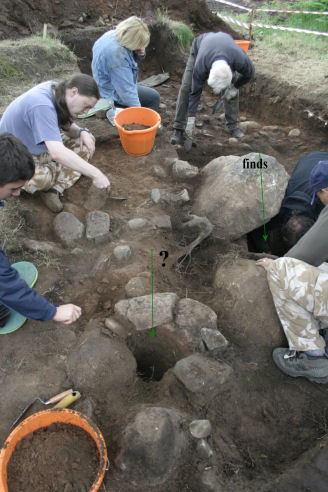|
 Last
month Mark Olly headed a team, including local volunteers, in excavating
the Lady Hill mound in Haydock; a site which is thought to be ancient (see
newsletter No.103). It lies on the edge of woodland just south of the
Haydock Racecourse and was once part of Haydock Manor. The whole area has
seen much activity over the centuries, including dams and reservoirs and a
man-made lake (now drained) just south of the site. In the 19th century
the fields round about were used as a pheasantry and during the war the
Americans were using the area to store their aircraft. Last
month Mark Olly headed a team, including local volunteers, in excavating
the Lady Hill mound in Haydock; a site which is thought to be ancient (see
newsletter No.103). It lies on the edge of woodland just south of the
Haydock Racecourse and was once part of Haydock Manor. The whole area has
seen much activity over the centuries, including dams and reservoirs and a
man-made lake (now drained) just south of the site. In the 19th century
the fields round about were used as a pheasantry and during the war the
Americans were using the area to store their aircraft.
Mark Olly's team included a contingent of scouts who
were using the dig as an opportunity to complete their Duke of Edinburgh
Awards. The weekend began with Mark opening a trench to the south of the
mound to investigate an anomaly shown on our resistivity survey. Nothing
emerged here except the underlying boulder clay so Mark extended the
trench toward the mound but again without anything to show. He then turned
his attentions to some large stones protruding from the top of the mound.
A trench was also opened just to the west of them. In this trench, at a
depth of about 50cm, the excavators came across a cobbled surface. When
our small team of 3 arrived on the Sunday, this surface had been exposed
as far as the edge of the mound. Our task was to investigating a strong
anomaly shown on the resistivity just to the north of the mound. This
turned out only to be underlying geology in the form of a deep layer of
sand. The sand was also evident in a trench that Mark next opened up on
the north side of the mound. In this area a mini digger was used, first to
cut through a layer of stone blocks which lay in a thick layer of black
topsoil.
At the end of the day with no finds to speak of the
only thing to say was that the mound was definitely man-made. The
following week Mark continued excavating the mound with the help of Derek
Pierce from STAG. A section through the cobbles near the edge of the mound
revealed a depth of about 20 to 30cm until the underlying sand reappeared.
However it was Mark's investigations between the big stones which produced
the best chance of producing a date. In a small cavity between the stones,
burnt material was recovered including small fragments of bone. Using
Carbon-14 dating a fairly accurate date can be obtained for this feature
which appears to be cremation burial. Before backfilling Ron Cowell from
Liverpool Museum was invited to examine the results. His conclusion is
that there is a possibility the mound could date from antiquity (maybe
Bronze Age or possibly even Dark Age). If this is confirmed it will
certainly be a remarkable find for this part of South Lancs. Steven Dowd,
who runs the Newton-le-Willows website (
www.n-le-w.co.uk ), has record all proceedings and is tasked with
writing the report. Bob Heyes should also be given credit for organising
the dig, which wouldn't have taken place without his dogged enthusiasm.
Roman Road Potential
Tom has confirmed that the land to the east of the old council refuse
tip in Higher Ince was not used for tipping. This means that there is a
good chance the Roman road could still exists here. This is another one to
add to our collection of Higher Ince sites which Tom is hopeful of getting
funding for, so that we can excavate them all properly.
Research Framework NW
Volume 2 (Agenda - Strategy) has now been published and Wigan gets a
special mention in the Roman section. It calls for much more research to
try to understand what was going on in Wigan in the early 2nd century AD.
Summer Trip
We have re-arranged our trip in
August for Sunday 26th and as suggested last month we will be
visiting the Ribblehead Viaduct. On the day a steam engine is scheduled to
cross it and Tom has also spotted a good place for lunch. In the afternoon
Neil Thompson of Wyre Archaeological Group has agreed to take us on a
guided tour around his ancient sites around the village of Nateby near
Garstang (see last month's newsletter). If you intend going please fill in
the slip provided (cost will be about £12 inc lunch).
Next WAS Meeting
Wednesday 4th July at the District Scout HQ (Baden Powell Centre) in
Greenough Street, starting at 7.30 pm as usual. This month we have Ron
Cowell (see above) who will be filling us on the details of his
excavations on the Romano-British site at Dutton Farm near Lathom. Ron is
also excavating a site at the M62-M57 junction where evidence of a Roman
tile kiln has been found. I'm sure he will be able to tell us more about
this and also his thoughts on the Lady Hill dig.
Hope to see you there
B.A.
|



